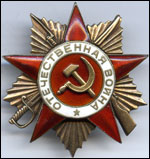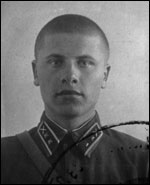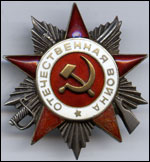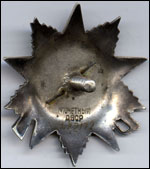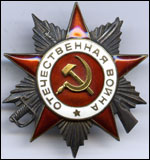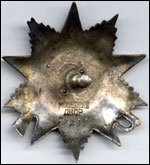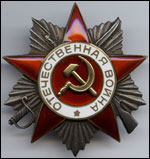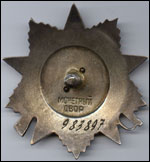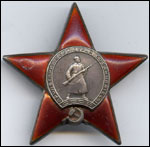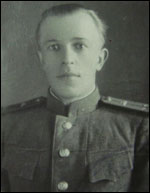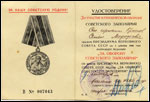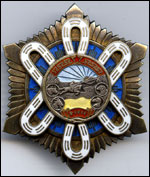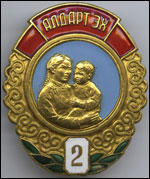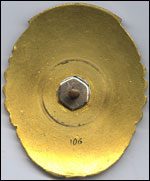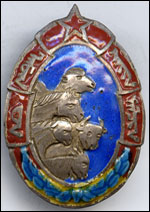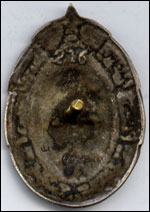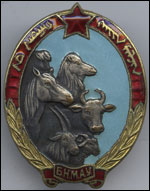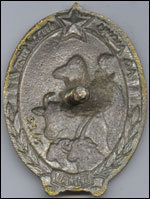|
A few interesting pieces On this page I have pictured and described a few interesting pieces from my personal collection: not necessarily expensive awards, but awards (or documents, or groups) that are unique or special in a certain way or simply rather uncommon. All awards have been scanned at 400 DPI. | |
Posthumous Soviet awards are rather scarce. Until 1977 the Soviet Union had a law requiring decorations to be returned to the state upon the recipient's death, the only exception to this rule being the Order of the Patriotic War. Therefore, the OPW was the only decoration that could be awarded posthumously and was actually given to the next of kin. The Hero of the Soviet Union title was often awarded posthumously as well, but the Gold Star Medal wasn't given to the family members of the deceased. Before 1977, several different Soviet orders were awarded posthumously, but other than the Hero of the Soviet Union title, the vast majority of pre-1977 posthumous awards were Orders of the Patriotic War. This specimen, a 1st Class award, is one of these. It was posthumously awarded to Lieutenant Colonel Grigory Starov, commander of the 1467th Anti-Aircraft Artillery Regiment, on April 30, 1944. Starov had been killed in action on April 5, 1944, only 26 years old. The photo shows Starov as an Artillery Lieutenant between 1938 and 1941. For the full translations of the award documents, see this page.
| |
The type 2 Order of the Patriotic War, 2nd Class comes in many visually quite distinctive variations. One of the most striking variants is the so-called "small" variation, also known as the "baby" or "fisheye" variation because of its smaller arms, but regular sized center. They are rather scarce; they were produced in two runs, both by the Leningrad Mint, one in February 1945 and the other one in March 1945. The upper two pictures show a piece from the first run. This batch consisted of 2,500 pieces, and the one shown has the highest observed serial number for this variation (482172). This number is also mentioned on the OPW2 page on the MedalsMarket (formerly Soviet Screwbacks) website. This is the rarest variation of the 950,000 type 2 OPW2s ever produced. Unfortunately the two lower enamelled arms of the order have been repaired, and the gold hammer and sickle emblem has been replaced by a brass one (which isn't very unusual). The second row of scans shows a specimen from the second run. The size of this batch is unknown; possibly around 40,000 pieces. This piece (nr. 592325) is in much better condition. The last scan shows a comparison of this "small" OPW2 with a bigger brother of the "concave reverse" variation (nr. 296650).
| |
This Order of the Patriotic War, 2nd Class, nr. 983897, was one of the last type 2 OPW2s ever produced. The type 2 was produced from 1943 to 1969; the very last batch, manufactured at the Moscow Mint in 1969, consisted of 15,000 pieces, 500 of which weren't serial numbered. The serial numbers for the other 14,500 pieces were 971201-985700 (the highest observed serial number is 985544), so this specimen is the 1804th highest numbered type 2 OPW2. This piece is of the so-called "ring reverse" variation, which can be observed on only the last 59,000 type 2 OPW2s. It is most likely a catch-up award for late wartime bravery. | |
This Red Star is not particularly rare or unique, but the story behind it is, I think, quite interesting. The star was awarded to the 19-year-old Private Vladimir Ivanov, a sapper-scout in the 341st Independent Sapper Battalion, 233rd Rifle Division, for deeds on the very last day of the battle of Stalingrad. The citation mentions the famous Barrikady Gun Factory. And to boot, it was one of my first researched awards. After the Stalingrad battle, Ivanov kept serving as a sapper, and after the war he was commissioned as a Lieutenant of Tank Troops. He retired a Captain in 1955, but later rejoined the army and eventually attained the rank of Lieutenant Colonel in 1975. The photo shows Ivanov as a Lieutenant of Tank Troops, sometime between 1948 and 1950. For the full translations of the award documents, see this page.
| |
With approximately 354,000 pieces awarded, the Medal for the Defense of the Soviet Polar Region, instituted on December 5, 1944, is one of the more uncommon Soviet campaign medals. The documents for these medals are even more uncommon. When I'm contemplating purchasing award documents, I always look for interesting signees. In this case the document was awarded to Senior Sergeant Semyon Krasnov, and signed on September 9, 1945 by Lieutenant General Arkady Apollonov, the Chief of the Internal Troops of the NKVD. Apollonov played an important part in, among others, the deportations of the Chechen and Ingush populations of the North Caucasus to Kazakhstan in early 1944, and, as an NKVD Plenipotentiary, the deportations of Germans from Eastern Prussia in the spring of 1945. In the second half of the 1940s Apollonov served as Deputy Minister of Internal Affairs and in the early 1950s as Deputy Minister of State Security. The only strange thing is that Apollonov was promoted to Lieutenant General on December 20, 1942 and to Colonel General on October 29, 1943, so did the clerk make a mistake when writing Apollonov's rank on the document? | |
And now something Mongolian, a type 2, variation 1 (as per The Orders and Medals of the Mongolian People's Republic by Khuujii Urnukh, 2010) Order of the Polar Star, serial number 696. Of the approximately 36,000 Polar Stars produced, 3,000 pieces were of this type, that distinguishes itself by the 1940 type Mongolian coat of arms with the abbreviation for "People's Republic of Mongolia" in classical Mongolian script. The type 2 can be broken down into two variations, the first of which was numbered roughly 1-1000 and was awarded between 1941 and 1945. Type 2 Polar Star nr. 600 was awarded in December 1943, so it could be that mine was also awarded around that time, but it seems that there wasn't really a chronological order and authorities just picked a random piece to hand out. | |
The Mongolian Order of Mother Heroine, 2nd Class was awarded to mothers for giving birth to and raising 5 to 8 children. Since over 210,000 2nd Class pieces were produced, this one with serial number 106 is a very early one. The order was instituted in 1957 and in 1958 the first ones were awarded, of both classes, to more than 17,000 mothers, so this specimen was probably part of that batch. | |
This peculiar badge is the first type of the Mongolian Best Herder Badge. They were made in the People's Republic of Mongolia in the mid-1920s and the primitive and crude craftmanship is very striking. It seems that the first 400 pieces had an integral serial number (including this specimen, number 216) and the next 400 had an engraved number (according to another source, a grand total of 1400 of these badges were made). Even the screwplate looks more like a millennium-old coin than a part of a 20th-century award. After this experience, production of the Best Herder Badges - just like all other Mongolian decorations - was transfered to the Moscow Mint in the Soviet Union. No less than about 45 years later would the Mongolians make a second attempt at manufacturing awards themselves. The crude appearance of these badges has been the reason of such nicknames as the "dinosaur variation".
| |
And this is how the Moscow Mint designed and produced the new type of the Mongolian Best Herder Badge (see above for the poor Mongolian attempt). This badge is simply beautiful and of high quality. Not much is known about it. Over the years, several variations were created. These ones are mirror reverse variations of the type 2, the lowest observed serial number of which is 32 and the highest 4100. These badges were produced by the Moscow Mint, and judging by the serial number style and the fact that there's still classical Mongolian script along the edge (the Mongolian People's Republic adopted the Cyrillic alphabet in 1941, which was incorporated in all newly produced awards), before 1945. Incidentally, I have both #3344 and #3345. The chances of finding two consecutive serial numbers are slim, I bought these together and their condition is similar, so maybe they were unissued stock, or awarded to the same recipient?
| |
All rights reserved / alle rechten voorbehouden © Auke de Vlieger 2008-
Home
